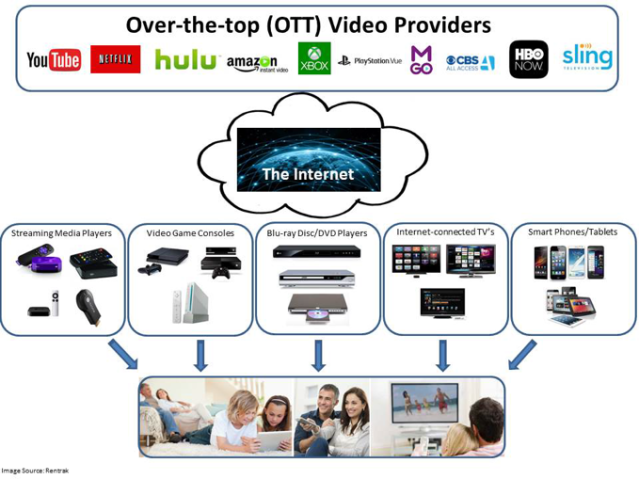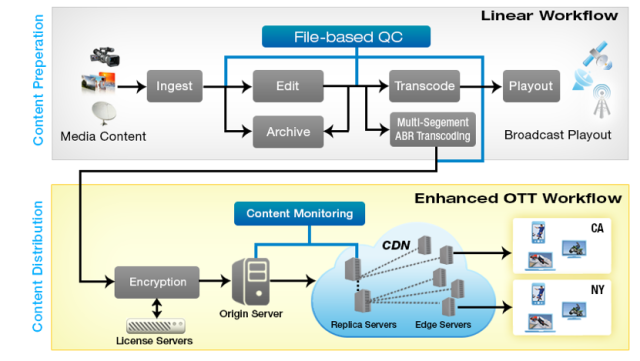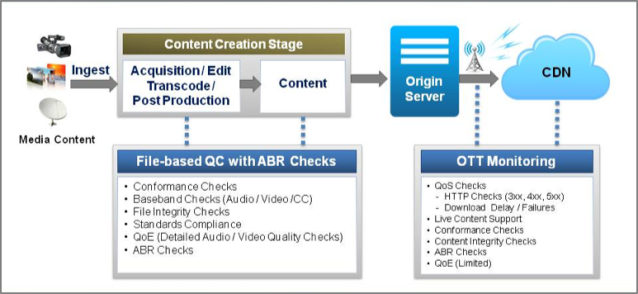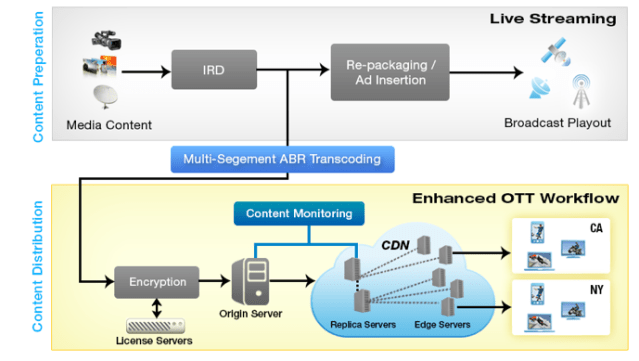Introduction
OTT and video streaming are here to stay. Millennials are increasingly watching content on their mobile devices and computers and a 71% growth in viewership has been observed since 2012. However, watching video on mobile devices is not limited to the youth. In the US, 86% of smartphone users watch video content on their phones. [1] Broadcasters need to brace up for the changing viewing styles by embracing Over-The-Top (OTT) workflows, which threatens to take the center stage if the viewing patterns are any indication. Ensuring right delivery of technically sound content is critical for every broadcaster. The right set of Quality Control tools are a must to ensure that you stay ahead in the OTT race.
The Changing Face of Media Delivery
The traditional broadcast delivery is a linear flow with content being pushed downstream to set top boxes on the consumer side. The channel of delivery may be cable or satellite, DTH or IP network. The delivery format is singular and resolutions are SD, HD or UHD. Users view the content on their TV sets. But this mode of programming has been rapidly changing. Viewers are increasingly shifting to watch content when they want, where they want and on the device they want. Content needs to be streamed as per user requirements, on demand and as per the resolution of the playing device. The content is now being pulled by the consumers as per their needs. Broadcasters need to ready their content for this mode of playback – they don’t control the delivery, consumer does. Welcome OTT!
What is OTT?
OTT uses the Internet to bring audio-video content to the consumer. As opposed to traditional video distribution methods, which operate under a dedicated and controlled network, OTT video uses the Internet, which is an unmanaged network, used across the globe by millions of people. OTT content from broadcasters and video service providers typically include streaming of content such as TV programs, movies, live sports, and other special events. YouTube videos are also a prime example of OTT video. Other OTT providers include Amazon, Netflix, Hulu, etc.

To enable OTT deliveries, broadcasters need to embrace multiple technologies, more complex than the traditional linear flow – a delivery where the content is repurposed based on the user device, the quality/bandwidth of the delivery is changed based on the network congestion, and the content is not broadcasted to multitudes, but pulled by individual consumers. This is achieved using adaptive bit-rate (ABR) technology.
What is ABR?
With ABR, multiple versions of a video are created – each version encoded at a different bit rate and profile. Each of these versions is further broken into short-duration segment, which is aligned with the same segment in other versions. Depending on the network bandwidth available on the consumer device, an appropriate segment from a specific file is sent to the user. This assures that the user receives the best quality video in an uninterrupted manner.
Different wrapper formats have emerged for ABR technology, the most popular ones being HLS, DASH and HSS. Different devices consume different streaming formats, for example, Android and iOS devices consume HLS (now a universal streaming format), Microsoft XBOX, Windows8 phones can consume HLS / HSS and so on. For a broadcaster, embracing these multiple OTT formats over and above the linear flow has suddenly made their life a lot more complex. And amid this complexity, one is still struggling to cost effectively provide streaming option in addition to traditional deliveries.
OTT workflow – Video-on-Demand (VOD) vs. Live Streams
For the purpose of this document, we would like to distinguish OTT workflows based on whether we are talking about stored program content or live programming. Stored programs are managed using file-based workflows typically as VOD assets. Here, the broadcaster has the time and luxury to ensure quality of assets during the content preparation stage using file-based QC tools. BATON® ABR, as discussed later, serves the need very well at this stage. However, in the case of live-streams, content is transcoded in real-time into the chosen ABR formats and made available for streaming. In both the cases, any delivery issues with real-time streaming are verified using real-time OTT content monitoring tools like ORION™-OTT, discussed later in this document. The next sections discuss the QC and monitoring needs for both the workflows in further details.
QC & MONITORING for VOD assets in OTT workflow
To be able to effectively monetize OTT for VOD assets, the media
companies need a unified QC & monitoring solution, as shown in Fig.
1, for content preparation as well as content distribution to ensure
good experience for viewers in the OTT/ABR world.

Figure 1. Typical Broadcast Workflow Enhanced with the OTT Delivery Flows
Next, let us look at the QC needs during the content preparation stage, and the monitoring during the content distribution stage.
QC DURING CONTENT PREPARATION
You need to ensure that the quality of original content is good. At the content preparation stage, file-based QC solutions like Interra Systems’ BATON® helps you to address quality challenges, quite comfortably. From ingest to editing issues, compression artifacts introduced during transcoding, as well as file assembly issues – most are easily identified by the modern QC tools.
You must deploy the right QC tools that match your quality needs for the content preparation stage to mitigate your risks and ensure that technically sound content is ready for delivery.
The QC checks can be broadly classified as follows:
Baseband Quality Checks
It is important to ensure that the content is checked on various quality parameters before the final delivery. A comprehensive QC tool needs to be used for a wide range of baseband quality checks, such as video signal levels, color bleeding, blotches, blur, defective pixels, black frames, color bars, RGB color gamut, mosquito noise, audio levels, audio noise and a host of other such artifacts. Good QC tool must ensure that these are detected with high level of accuracy and reliability and minimal false positives.

Chroma Phase Error
Compression Artifacts
When the content is compressed, several compression artifacts like blockiness, pixelation, Moire pattern, ringing artifacts, and more can get introduced in the lossy compressed video. A good QC tool needs to ensure that the transcoded content is free from these artifacts.
File Integrity and Standards Compliance Checks
The file integrity and compliance checks ensure that the file or content being delivered is not corrupt and has been encoded as per the standard to ensure that the downstream tools are able to play it without issues. This becomes even more important in the OTT context, where there are a host of devices with different form factors and players from multitude of vendors – and the content is expected to play well on all of those devices.
Multi-Segment ABR Transcoding
Once master/mezzanine content has been verified using a file-based QC solution, it can be subsequently submitted for ABR transcoding. ABR transcoding is a complex process involving creation of multiple renditions of the same content at different quality levels/bitrates. The transcoding process is not only time consuming but also needs to ensure proper alignment between different variants and rightful segmentation of each variant. Failure to achieve this would result in playback issues leading to revenue loss. That’s where different file-based QC & monitoring and systems come into the picture. These tools can check for ABR specific issues and alarm user before ABR package goes out for delivery.
OTT delivery, as discussed earlier, deploys the ABR technology. ABR requires content to be split into short segments of typically 10 seconds each. This ensures seamless and fast switching between different variants. Typically each ABR package is encoded at multiple bitrates (typically three or more). When the content is played, the streamed content switches between different bitrates as it moves to the next chunk, managed using the manifest file and depending on the network congestion and other factors influencing delivery quality.
When content is transcoded for ABR playback, several additional checks need to be done on the transcoded content to ensure that the content is ABR ready. Some of those checks are listed below:
Checks to ensure each segment starts with an independent frame. This is to ensure that any chunk does not have any decoding dependency on the previous one, so that during playback, a seamless switch can happen when moving from one chunk to another.
Checks to ensure that all variants of the content are properly
aligned in terms of number of segments, segment duration, total duration
and content structure. A client can choose to playback a particular
variant depending on the download bandwidth available and device screen
size, therefore, it is imperative to ensure that all the variants are
consistent with each other and allow seamless switching across all of
the available variants.
Ensure consistency between metadata and actual content properties.
A client uses the metadata in the manifest files to choose the best
playback quality. If there is any inconsistency between the metadata and
the actual media properties, it may lead to playback issues and hence a
bad user experience.
Once the content is validated on these checks, it is ready for delivery, both for linear as well as OTT flows. The content is encrypted with one or more DRM technologies before it is moved to the origin server for OTT delivery.
A good file-based QC solution should have capability to perform all of the above ABR checks and also do a deep analysis to identify any baseband issue. Once the content moves to the distribution stage, the focus shifts to ensuring a smooth content delivery and the best possible user experience. This creates a need for state-of-the-art monitoring solutions that can ensure a superior QoS as well as baseline QoE. The next section talks about the monitoring requirements in detail.
MONITORING DURING CONTENT DISTRIBUTION for VOD Assets
At this stage, we need to ensure that no issues will be encountered during delivery of VOD content – in short ensure QoS as well as QoE. The monitoring requirement at this stage is to perform real-time streaming validations. There is some overlap with the File-QC done during the content preparation stage, and that is necessary to ensure the content sanity as it is replicated from the origin server to cache/replica servers in a typical distribution or Content Distribution Network (CDN) environment. However, the accuracy and details of file-based QC are not needed at this stage. It is sufficient to do limited QC which is significantly faster. Monitoring tools at this stage need to ensure the following:
The content manifest should be accessible over HTTP/HTTPS and all the
references to profile manifests and individual segments should be
accessible
Ensure that the content is properly conditioned for ABR (refer to ABR checks in the previous section)
Server responds fast enough to ensure that content is downloaded within
acceptable delays and buffering needs -this can have a major impact on
the playback experience for a user
Content downloads are simulated in network congestion environment to
observe how the distribution server behaves under stress conditions
The content may also be decrypted at this stage to ensure that no issues were introduced during encryption
Basic audio-video quality checks (for example, blockiness, black frame, audio loudness etc.)
Passive monitoring of all the requests/responses for actual clients accessing the content
All HTTP response codes – 3xx,4xx,5xx should be monitored and logged
Several OTT monitoring solutions have emerged in the market. The OTT technology is still evolving and the requirements for what is needed for a monitoring solution at this point are also evolving. The monitoring tools need to be architecturally versatile to accommodate this evolving environment, while broadcasters figure out which issues are the most critical ones to focus on. The ideal scenario for VOD based assets is the one where OTT monitoring leverages the file-based QC tool, working in tandem and seamlessly with it. The Fig 2 below illustrates how a complete QC & monitoring solution works from ingest to delivery in the OTT world.
Figure 2: QC & Monitoring – Adaptive Bitrate Streaming

ABR Transcoding & MONITORING for OTT Live Streams
The typical live stream workflow enhanced for OTT deliveries is shown below in Fig. 3. The live stream is split into segments, and as segments are received, they are transcoded in real-time to the desired ABR format. The segments are encrypted using any of the popular DRM technologies and placed for consumption real-time on the origin servers. More segments get added while the older ones get removed. The process continues through the duration of the live content.
As evident, a full file-based QC does not play a role here. However, we still need to ensure the following:
Basic baseband checks are done. The segments that the live content is chopped into is free from basic baseband quality issues
ABR transcoding is happening properly. ABR segments are “good”, complying with the ABR specs to ensure seamless delivery
Timing and the load is well managed. ABR segments are made available at
the right time on the servers, and the servers are able to manage the
load
Essentially, on the live content, we need to perform basic segment integrity and content quality checks, ABR transcoding checks and file download checks. In short, ensure QoS and baseline QoE checks on the growing content. These checks are performed using content monitoring tools like ORION-OTT, similar to the VOD flow.
Figure 3: Monitoring for Live Streams in OTT Workflow

QC & MONITORING solutions for ott Enhanced workflows
Interra Systems provides end-to-end seamless and versatile solutions for software-based content verification, monitoring, and analysis solutions for file-based and real-time workflows in the digital media industry.
To ensure the quality of original content for VOD assets, Interra Systems’ BATON® ABR identifies quality issues from ingest to editing, compression artifacts, as well as file assembly issues. Once the content is validated with BATON ABR, it is ready for OTT delivery. Real-time streaming validations, both for VOD assets and live streams, are done with Interra Systems’ ORION™ – OTT.
Conclusion
OTT technology is still evolving, and the requirements for monitoring are also changing. Monitoring tools need to be architecturally versatile in order to accommodate this environment and allow broadcasters to figure out which issues are the most critical ones to focus on. Ultimately, broadcasters should choose an OTT monitoring solution for Live and VOD assets that works in tandem with a file-based QC tool. By deploying a complete QC and monitoring solution for ingest to delivery, broadcasters can deliver the best QoS and QoE to viewers in the OTT world.
[1] Ericsson: TV AND MEDIA 2015|The empowered TV and media consumer’s influence
Thought Gallery Channel:
Tech Talk
